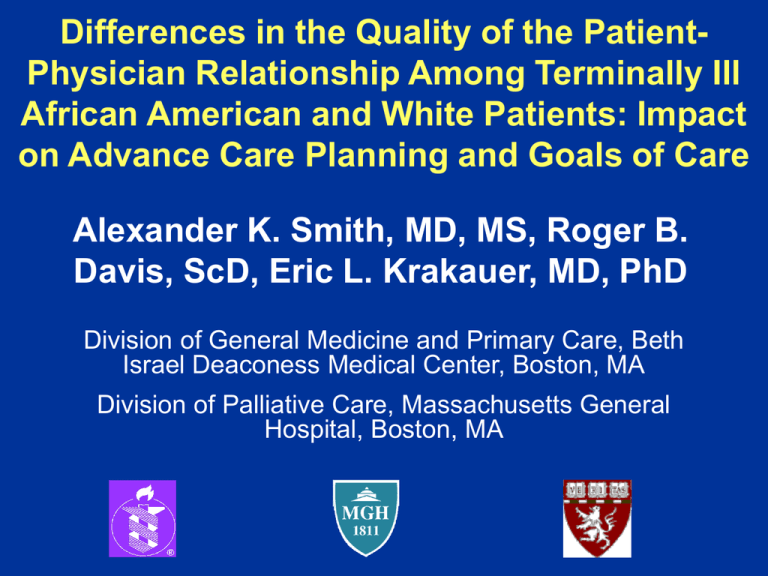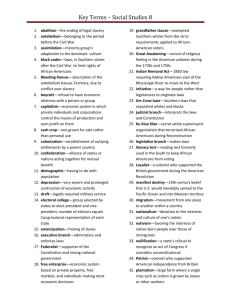
Differences in the Quality of the PatientPhysician Relationship Among Terminally Ill
African American and White Patients: Impact
on Advance Care Planning and Goals of Care
Alexander K. Smith, MD, MS, Roger B.
Davis, ScD, Eric L. Krakauer, MD, PhD
Division of General Medicine and Primary Care, Beth
Israel Deaconess Medical Center, Boston, MA
Division of Palliative Care, Massachusetts General
Hospital, Boston, MA
Previous Disparities Research
• African Americans, compared to Whites:
– greater preference for life-sustaining
treatment
– less likely to have living will or HCP
– report lower quality interactions with their
physicians
• Impact of relationship quality on care: may
be magnified in terminal illness
Aims
• To compare the quality of the patientphysician relationship between terminally
ill African-American and White patients
• To examine the extent to which quality of
the relationship contributes to differences
between African Americans and Whites in
advance care planning and goals of care
Study sample
• In-person surveys: Commonwealth
Cummings study
• 803 African American and White patients
• Physician estimated survival of ≤ 6 months
• Referred from randomly selected
physicians: 5 metropolitan areas, 1 rural
county
• Response rate 87%
• 1996-1997
Patient-Physician Relationship
Measures
• 6 patient reported patient-physician relationship
quality measures (4 point scale, dichotomized at
strongly agree vs. other responses):
–
–
–
–
–
–
Trust in physician
Feels respected by physician
Physician skilled in breaking bad news
Physician skilled at listening
Physician shares decision making
Physician helps navigate the medical system
Advance Care Planning and Goals
of Care
• Presence of an advance care plan (any of
following)
– Living will
– Health care proxy
– Talked with family about plans for EOL care
– Talked with physician about plans for EOL
care
• Goal of “prolong life however possible”
Statistical Analysis
• Predictor: African American vs. White
• Estimated relative risks using Poisson
regression with robust error variances
• Sequential models:
– Unadjusted
– Adjusted for age, gender, education, primary
disease, and recruitment site
– Adjusted for age, gender, education, primary
disease, recruitment site, and all measures of the
quality of the patient-physician relationship
Sample Characteristics
African
American
(n=115)
White
(n=688)
Age < 65
52%
42%
Female Sex, %
66%
51%
Income <$15,000
63%
31%
Less than high school graduate
55%
26%
Cancer
48%
54%
Heart Disease
14%
18%
COPD
5%
13%
Renal Disease
13%
1%
Other
20%
15%
Primary Disease
Patient Reported Quality of the PatientPhysician Relationship, Terminally Ill African
Americans Compared to Whites
100
% Strongly Agree
*
80
*
*
*
*
Physician
Skilled in
Breaking
Bad News
Physician
Skilled at
Listening
Physician
Shares
Decision
Making
Physician
Help
Navigating
the Medical
System
60
40
20
0
Trust in
Physician
White
African
American
Feels
Respected
by
Physician
* p<.05; trust in physician, p=.08
Goals and Advance Care Planning,,
Terminally Ill African Americans Compared
to Whites
100
White
*
80
*
African
American
%
60
40
20
0
Has Advance Care Plan
* p<.05
Goal "Prolong Life However
Possible"
Goals and Advance Care Planning,,
Terminally Ill African Americans Compared
to Whites
100
White
80
*
*
*
%
60
African
American
40
20
0
Has Living Will
* p<.05
Has Health Care
Talked with
Talked with
Proxy
Family about EOL Physician about
Plans
EOL Plans
Relative Risk of Having an Advance Care Plan
African Americans Compared to Whites
Unadjusted
Adjusted for age, sex,
education, primary disease, and
recruitment site
Adjusted for age, sex, education,
primary disease, recruitment site,
and all measures of the quality of
the patient-physician relationship
0.2
0.6
1.0
Relative Risk
(Reference group is Whites, RR=1.0)
Relative Risk of a Goal of “Prolong Life However Possible”
African Americans Compared to Whites
Unadjusted
Adjusted for age, sex,
education, primary disease, and
recruitment site
Adjusted for age, sex, education,
primary disease, recruitment site,
and all measures of the quality of
the patient-physician relationship
0
1.0
2.0
3.0
Relative Risk
(Reference group is Whites, RR=1.0)
4.0
Summary
• Among this terminally ill sample of patients
– compared to Whites, African Americans gave lower
ratings of the quality of the patient-physician
relationship
– While 80% of Whites had an advance care plan, less
than half of the African Americans had an advanced
care plan.
– Patient reported quality of the patient-physician
relationship did not explain differences in advance
care planning and goals of care between AfricanAmericans and Whites.
Limitations
• Data from 1996-1997
• Single measure of race/ethnicity
• Physicians may have referred patients
with strong relationships
• Cross sectional study
Conclusions/Implications
• Physicians referred patients prognosis ≤ 6
months, yet only 25% of physicians talked
with patients about plans for EOL care
• In the context of low overall discussion
rate, quality of the patient-physician
relationship had no impact on differences
in advance care planning and goals of
care
Conclusions/Implications
• Focus: improving physician relationships
with African American patients
• Future research should search for other
potential mediating factors:
– Values
– Cultural beliefs
– Health literacy
– Attitudes toward the health care system
– Treatment by the health care system
Thank you






